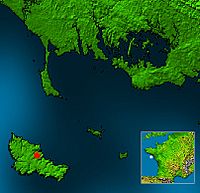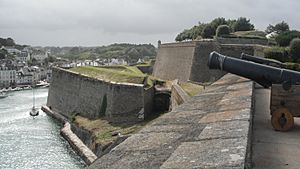Capture of Belle Île facts for kids
Quick facts for kids Capture of Belle Île |
|||||||
|---|---|---|---|---|---|---|---|
| Part of Seven Years' War | |||||||
 An exact presentation of the capture by the British fleet |
|||||||
|
|||||||
| Belligerents | |||||||
| Commanders and leaders | |||||||
| Strength | |||||||
| 9,000 | 3,000 | ||||||
| Casualties and losses | |||||||
| Unknown | Unknown | ||||||
The Capture of Belle Île was a military operation by the British to take the French island of Belle Île. This island is located off the coast of Brittany, France. The event happened in 1761 during the Seven Years' War.
At first, a British attack was pushed back. But a second attempt, led by General Studholme Hodgson, managed to get troops onto the island. After this first landing, another one took place. The British then began a six-week siege of the island's main fort, called a citadel, at Le Palais. They eventually captured it, giving Britain control of the island. France tried to send help from the mainland, but the British navy controlled the sea, so no help could reach the island. The British held Belle Île for two years. They gave it back to France in 1763 after the Treaty of Paris was signed.
Contents
Why did Britain attack Belle Île?

In 1756, Britain and France officially started the Seven Years' War. This war began with fights in North America. France had some early success, like capturing Menorca, a British island in the Mediterranean Sea.
However, Britain soon gained control of the seas. They started launching attacks on the French coast. These raids, like the one on Rochefort in 1757, were led by William Pitt, a powerful British leader. Even though these attacks didn't always achieve big goals, they made France worried. France had to send many soldiers to guard its coast.
In 1759, France tried to invade Britain. But the British navy defeated the French in major sea battles. This meant France's invasion plan had to be stopped. For most of the rest of the war, the French navy stayed in its ports.
Britain also attacked French colonies around the world. They captured many of them, including Canada in 1759-1760. Pitt hoped these victories would lead to a peace agreement.
Pitt wanted to capture something important that Britain could trade for land they had lost. He decided to focus on the French coast. The island of Belle Île was near a major French naval base. It was also a good spot to control the Bay of Biscay. Pitt believed it could become a British military base. From there, Britain could launch more attacks on the French mainland.
Some important British admirals, like Lord Anson and Sir Edward Hawke, didn't think attacking Belle Île was a good idea. But Pitt was determined. On March 25, 1761, King George III secretly approved the plan. General Studholme Hodgson was chosen to lead the army. Admiral Augustus Keppel, who had experience with landing troops from ships, led the navy.
The Fight for Belle Île
First Landing Attempt
The British forces gathered at Plymouth and sailed on March 29, 1761. Bad weather delayed them, but they reached Belle Île on April 6. After looking at the island, they decided to try landing near Port Andro, on the south side.
A group of soldiers, led by General John Craufurd, tried to land. The British also made a fake attack to the north. This was meant to distract the French defenders.
However, Craufurd's troops faced strong resistance. The French were well-hidden in their defenses. Their gunfire caused many British casualties. Some British soldiers managed to climb the cliffs, but they didn't get enough support. Many were killed or captured.
The British realized they had lost the element of surprise. Craufurd's troops gave up and went back to their ships. A big storm then hit, damaging many of the boats needed for landing. The British commanders thought another attempt wouldn't work. They wrote to Pitt, suggesting they should go home.
News of the failed attack disappointed both Paris and London. But Pitt insisted on a second attempt. More troops and ships were sent to join Admiral Keppel. Pitt was determined to capture the island.
Second Landing and Victory

With more forces, Keppel and Hodgson planned a second landing. After carefully studying the island's defenses, they decided to attack Port Andro again. This time, they planned two fake attacks. One was to the west, and another to the north at St Foy.
On April 22, the main attack at Port Andro, again led by John Craufurd, faced strong resistance and quickly stopped. Meanwhile, the fake attack to the north, led by Brigadier Hamilton Lambart, found the coast near St Foy unguarded. The French thought the high cliffs there were enough protection.
Lambart decided his troops could climb the cliffs. They successfully reached the top. They fought off a French counter-attack, getting help from nearby British navy ships.
When Craufurd realized what had happened, he stopped his attack. He took his troops by boat to help Lambart. The British commanders sent more soldiers to secure their position on the island. By nightfall, all the British forces were ashore.
As planned, the French soldiers and island residents retreated into the main fort at Le Palais. This left the rest of the island open to the British. The British now controlled the island's ports, allowing them to bring in supplies. They began to siege Le Palais.
The French commander, the Chevalier Sainte Croix, hoped he could hold out long enough for help to arrive from mainland France. The French Governor of Brittany had gathered troops to help Belle Île. But British ships kept a close watch on the coast. The British control of the sea made it impossible for French help to cross.
On June 8, after more than a month of siege, Sainte Croix knew no rescue was coming. He agreed to surrender. Sainte Croix and his men were allowed to march out of the fort with military honors. They were then sent back to nearby Lorient in France.
British Control of Belle Île
After the capture, the British governed Belle Île for two years.
Governors of Belle Île
- John Craufurd: He was the first governor, starting on December 24, 1761.
- Hamilton Lambart: He took over as "Senior Officer" when John Craufurd left on March 17, 1762.
- James Forrester: On June 21, 1762, Lt. Col. James Forrester became the governor, replacing Lambart.
The Deputy Governor was Lt. Col. Thomas Oswald. He had been part of the British forces that captured the island.
According to the Treaty of Paris (1763), signed on March 10, 1763, Belle Île was to be returned to France. Forrester handed the island over to the French commander on May 10, 1763. Forrester and the British forces left Belle Île the next day.
What Happened Next?
At first, France said Britain could keep Belle Île if they wanted. But they soon realized this wasn't a good idea. The island could be used by British ships to attack French trade.
So, after two years, Belle Île was given back to France as part of the Treaty of Paris. In return, Britain got back Menorca, another island they had lost.
Later, some French-speaking people called Acadians settled on Belle Île. They had been forced to leave their homes in North America by the British. However, the Acadians were not happy with the conditions on Belle Île. By 1785, most of them had moved to Louisiana.
Images for kids




